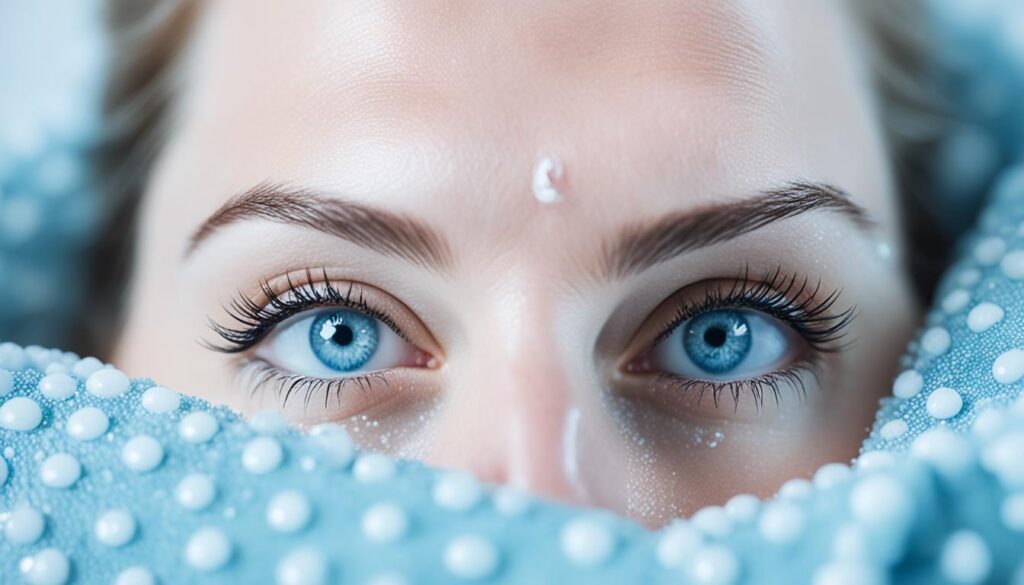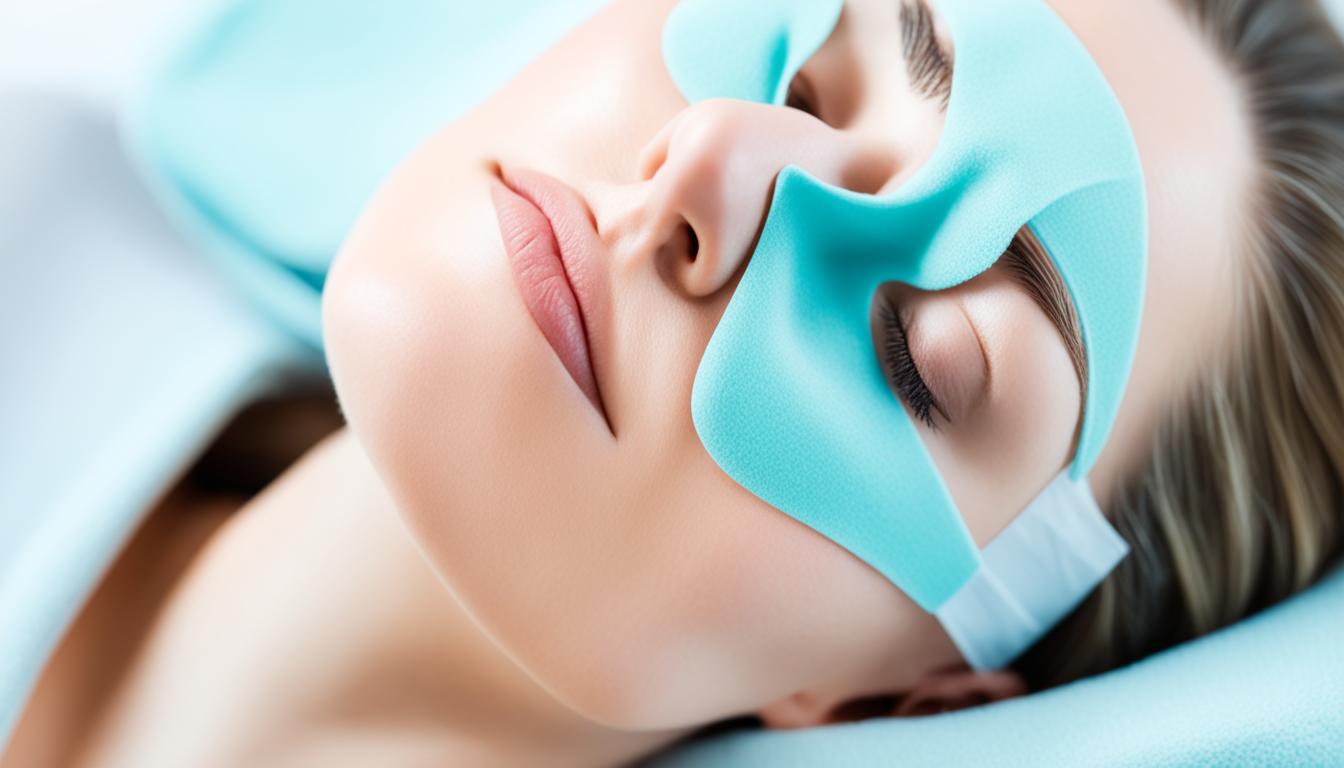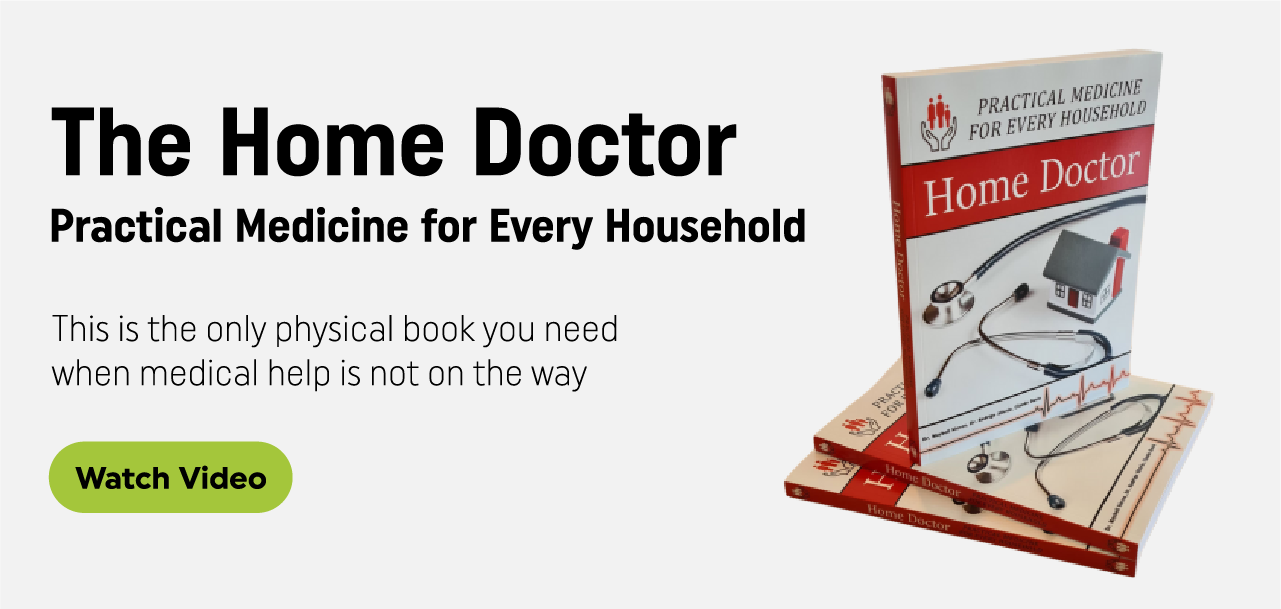Placing a cold compress on your eyes can provide immediate relief from inflammation and help keep your eyes feeling and looking fresh every day. Cold compresses have numerous benefits for various eye conditions, including dry eye disease, eye allergies, and pink eye. They can also be used for everyday comfort and relief from eye puffiness and fatigue.
Key Takeaways:
- Cold compresses can provide immediate relief and reduce inflammation in the eyes.
- They are beneficial for eye conditions such as dry eye disease, eye allergies, and pink eye.
- Cold compresses can help alleviate eye puffiness and fatigue.
- Using cold compresses regularly as part of an eye care routine promotes overall eye wellness.
- Consult with healthcare professionals or eye doctors for personalized advice and treatment options.
The Benefits of Cold Compresses for Eye Health
Cold compresses offer multiple benefits for eye health. They are a natural and cost-effective solution that can provide immediate relief and promote long-term eye wellness. Here are some key advantages of using cold compresses for eye care:
Soothing Relief for Eye Conditions
Cold compresses can effectively soothe and relieve symptoms associated with common eye conditions. For individuals experiencing dry eye disease, cold compresses can help reduce irritation, redness, and eye strain. They provide a cooling sensation that hydrates and rejuvenates the eyes, promoting overall comfort and well-being.
Reducing Eye Puffiness and Fatigue
One of the significant benefits of cold compresses is their ability to reduce eye puffiness and fatigue. By restricting blood circulation around the eyes, cold compresses effectively decrease swelling and alleviate discomfort. Whether you’ve had a long day or a sleepless night, applying a cold compress can revitalize tired eyes and provide a refreshing sensation.
Promoting Healthy Blood Circulation
Cold compresses work by reducing blood flow to the area, which in turn helps to reduce swelling and pain. This reduction in blood circulation can be particularly beneficial for individuals with eye allergies and pink eye, as it helps alleviate inflammation and redness. By applying a cold compress, you can alleviate discomfort and promote a healthier, more vibrant appearance for your eyes.
Convenient and Easy to Use
Cold compresses are convenient eye care tools that can be used in the comfort of your own home. You can easily create a cold compress by placing a clean towel soaked in cold water or ice cubes in a plastic bag wrapped in a towel. Alternatively, you can choose gel-filled cold compresses available at local drugstores. These pre-made compresses offer a hassle-free solution, eliminating the need for refrigeration.
| Benefits of Cold Compresses for Eye Health | Description |
|---|---|
| Soothes and Relieves | Alleviates symptoms of dry eye disease, eye allergies, and pink eye |
| Reduces Puffiness and Fatigue | Decreases eye puffiness and fatigue, revitalizing tired eyes |
| Promotes Healthy Blood Circulation | Restricts blood flow to reduce swelling and discomfort |
| Convenient and Easy to Use | Simple and accessible eye care tool for use at home |
Overall, cold compresses provide a range of benefits for eye health. By incorporating them into your eye care routine, you can experience relief from common eye conditions, reduce puffiness and fatigue, and promote healthy blood circulation. Enjoy the convenience and effectiveness of cold compresses in maintaining optimal eye wellness.
When to Use a Cold Compress vs. a Warm Compress
The choice between a cold compress and a warm compress depends on the specific eye condition and symptoms. Cold compresses are more suitable for reducing inflammation, pain, and redness associated with eye allergies, pink eye, and dry eye flare-ups. On the other hand, warm compresses are often recommended for conditions like meibomian gland dysfunction (MGD) and blepharitis, as they help promote proper tear drainage.
A cold compress is particularly effective for alleviating symptoms such as swollen and itchy eyes caused by eye allergies. The cold temperature helps constrict blood vessels, reducing inflammation and discomfort. It can also provide relief from the redness and irritation associated with pink eye. Cold compresses are also beneficial for individuals experiencing dry eye flare-ups. The coolness helps soothe the burning sensation and reduces dryness, providing immediate relief.
A warm compress is commonly used for conditions like meibomian gland dysfunction (MGD) and blepharitis. These conditions involve the dysfunction of the oil-producing glands in the eyelids, leading to blocked tear ducts and inflammation. A warm compress can help soften the oil in the glands, promoting better tear flow and drainage. This heat therapy aids in relieving discomfort and reducing the risk of infection.
It is important to consult with a healthcare professional or eye doctor to determine the most appropriate treatment for your specific eye condition.
By understanding when to use a cold compress or a warm compress, you can effectively manage your eye health and find relief from various eye conditions. Tailoring your treatment approach based on the specific symptoms and condition will ensure optimal results and promote overall eye wellness.
| Condition | When to Use a Cold Compress | When to Use a Warm Compress |
|---|---|---|
| Eye Allergies | Reduces inflammation and itching | N/A |
| Pink Eye | Reduces redness and discomfort | N/A |
| Dry Eye Flare-ups | Soothes burning sensation and dryness | N/A |
| Meibomian Gland Dysfunction (MGD) | N/A | Promotes better tear flow and drainage |
| Blepharitis | N/A | Softens oil in the glands, relieves discomfort |
DIY Cold Compress Techniques
When it comes to relieving eye discomfort and promoting natural eye care, making your own cold compress is a simple and effective solution. By using common household items, you can create a soothing cold compress to help reduce inflammation and rejuvenate your eyes.
Here are a few easy DIY cold compress techniques:
- Towel Compress: Begin by soaking a clean towel in cold water. Squeeze out any excess water and fold the towel to a comfortable size. Gently place the chilled towel over your closed eyes and relax for 10-15 minutes. The cool temperature will help alleviate eye puffiness and provide a refreshing sensation.
- Ice Bag Compress: Take a plastic bag and fill it with ice cubes. Wrap the bag in a towel to create a barrier between the ice and your skin. Place the wrapped ice bag on your closed eyelids for short intervals, around 5-10 minutes. Be sure to take breaks to avoid prolonged exposure to the cold temperature.
- Gel-Filled Cold Compress: If you prefer a more convenient option, gel-filled cold compresses are available at drugstores. However, keep in mind that these compresses may require refrigeration and could sometimes contain chemicals that should not come into direct contact with your eyes.
For a hassle-free and safe alternative, consider using self-cooling gel eye masks like CorneaCare’s Rescue hydrogel cold compress. These innovative masks provide cooling relief without the need for refrigeration or any chemical exposure.
Incorporating these natural eye care techniques into your routine can help reduce eye fatigue, alleviate puffiness, and promote overall eye health.
Cold Compresses for Common Eye Conditions
When it comes to alleviating symptoms of common eye conditions, cold compresses are highly effective. Whether you’re dealing with dry eye disease, eye allergies, or pink eye, a cold compress can provide much-needed relief.
For those suffering from dry eye disease, cold compresses help reduce irritation, redness, and eye strain. The cool temperature helps soothe the eyes and alleviate discomfort, making it easier to carry out daily activities without any hindrance.
Eye allergies can be particularly bothersome, causing swelling and itching. Applying a cold compress can help reduce the swelling and alleviate the itching, providing immediate relief from the irritating symptoms.
Pink eye, also known as conjunctivitis, is a highly contagious infection that leads to redness and discomfort. Although a cold compress won’t cure the infection, it can alleviate symptoms such as swelling and discomfort, providing a soothing sensation to the affected eyes.
If you experience persistent or worsening symptoms, it is essential to seek medical advice from an eye doctor for proper diagnosis and treatment. They can provide you with expert guidance tailored to your specific condition.
By incorporating cold compresses into your eye care routine, you can effectively manage the symptoms of these common eye conditions and promote overall eye health.

Table: Comparison of the Benefits of Cold Compresses for Common Eye Conditions
| Eye Condition | Benefits of Cold Compresses |
|---|---|
| Dry Eye Disease | Reduces irritation, redness, and eye strain |
| Eye Allergies | Reduces swelling and itching |
| Pink Eye | Alleviates symptoms of swelling and discomfort |
Other Tips for Eye Health and Fatigue Relief
In addition to using cold compresses, there are other natural techniques that can promote eye health and relieve fatigue. By incorporating these practices into your daily routine, you can maintain healthy eyes and reduce eye strain. Here are some tips to consider:
1. Take regular breaks from screen time
Extended periods of screen time can cause eye strain and fatigue. It’s important to take regular breaks, look away from the screen, and focus on a distant object to relax your eyes. This technique, known as the 20-20-20 rule, involves looking at something 20 feet away for 20 seconds every 20 minutes.
2. Practice good eyelid hygiene
Clean eyelids can help prevent eye infections and irritation. Use a gentle cleanser to wash your eyelids daily and remove any debris or makeup. Be sure to rinse thoroughly and avoid rubbing your eyes, as this can lead to further irritation.
3. Stay hydrated
Dehydration can cause dry eyes and worsen eye fatigue. Drink an adequate amount of water throughout the day to keep your body and eyes hydrated. This can help alleviate dryness and promote overall eye health.
4. Get enough sleep
Lack of sleep can contribute to eye strain and fatigue. Aim for 7-9 hours of quality sleep each night to allow your eyes to rest and rejuvenate. Incorporating good sleep hygiene practices, such as maintaining a consistent sleep schedule and creating a relaxing sleep environment, can also contribute to better eye health.
5. Use eye drops
Artificial tears or lubricating eye drops can provide relief from dry eyes and reduce eye irritation. These drops help keep the eyes moisturized and can be used as needed throughout the day, especially if you spend extended periods in dry or air-conditioned environments.
6. Wear wraparound sunglasses
Exposure to sunlight and harmful ultraviolet (UV) rays can damage your eyes. Protect your eyes by wearing sunglasses that provide 100% UV protection. Wraparound sunglasses offer additional coverage and can help minimize eye strain caused by bright light.
7. Incorporate a balanced diet
A healthy diet rich in nutrients, vitamins, and antioxidants is essential for optimal eye health. Foods like dark leafy greens, berries, fish high in omega-3 fatty acids, and citrus fruits contain nutrients that support eye health. Consider incorporating these foods into your diet to promote overall eye wellness.

By following these natural eye care techniques, you can enhance your eye health and reduce eye fatigue. Remember to consult with an eye care professional if you experience persistent eye discomfort or if your symptoms worsen. Taking proactive steps to care for your eyes can help maintain clear vision and overall eye wellness.
Conclusion
Cold compresses are an essential tool in eye health care and can provide much-needed relief from a variety of eye conditions. Whether you’re dealing with eye allergies, dry eye disease, or simply need to refresh tired eyes, cold compresses offer immediate comfort and reduce inflammation. By incorporating cold compresses into your regular eye care routine, you can alleviate symptoms and promote overall eye wellness.
However, it’s important to remember that cold compresses are just one part of a comprehensive eye care plan. Consult with healthcare professionals or eye doctors for personalized advice and treatment options. Additionally, adopting natural eye care techniques such as taking regular breaks from screen time, practicing good eyelid hygiene, staying hydrated, and getting enough sleep can further enhance the health of your eyes.
By prioritizing your eye health and incorporating these natural techniques into your daily routine, you can enjoy refreshed and revitalized eyes. Remember, maintaining optimal eye wellness requires consistent care and attention. Take proactive steps to care for your eyes, and you’ll reap the benefits of clear vision and comfortable eyes for years to come.


